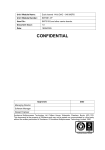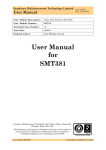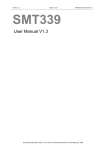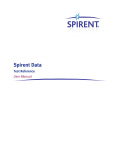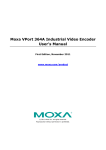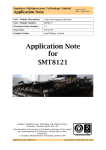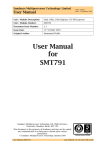Download SMT391-VP User Manual
Transcript
SMT391-VP User Manual Version 1.3 Page 2 of 41 SMT391-VP User Manual Revision History Date Comments Engineer Version 25/04/05 First release JPA 1.0 07/06/05 Added: power consumption SM 1.1 16/08/05 Updated: firmware JPA 1.2 JPA 1.3 Updated: triggers Updated: ddr sdram Updated: software Updated: registers Updated: introduction Updated: comport 22/11/05 Updated: firmware/SMT391 interface block Updated: description of the registers Updated: software Added link to SMT391 daughter module. Version 1.3 Page 3 of 41 SMT391-VP User Manual Table of Contents Revision History.......................................................................................................... 2 Table of Contents ....................................................................................................... 3 Introduction................................................................................................................. 6 Overview ................................................................................................................. 6 Module Features ..................................................................................................... 6 Possible Applications .............................................................................................. 6 Related Documents ................................................................................................ 7 Hardware overview..................................................................................................... 8 Block diagram ......................................................................................................... 8 ADC AT84AD001B ................................................................................................. 9 Analogue features................................................................................................... 9 FPGA ...................................................................................................................... 9 DDR SDRAM .......................................................................................................... 9 SLB ....................................................................................................................... 10 SDB ...................................................................................................................... 10 RSL ....................................................................................................................... 10 Comport ................................................................................................................ 10 LED ....................................................................................................................... 10 External triggers.................................................................................................... 10 Clocks generation ................................................................................................. 11 Firmware................................................................................................................... 11 Block diagram ....................................................................................................... 11 SMT391 interface block ........................................................................................ 11 ADC data interface ............................................................................................ 12 ADC 3-wire interface ......................................................................................... 12 PLL - VCO (LMX2330U) interface ..................................................................... 12 Clock synthesiser (SY89430) interface.............................................................. 12 External clocks .................................................................................................. 12 Triggers ............................................................................................................. 12 Registers block ..................................................................................................... 14 SDB ...................................................................................................................... 14 Version 1.3 Page 4 of 41 SMT391-VP User Manual RSL ....................................................................................................................... 14 Comport ................................................................................................................ 14 MPS430 block....................................................................................................... 14 Design Resource Usage ....................................................................................... 14 Software ................................................................................................................... 16 Library SMT391 .................................................................................................... 16 SMT391_Config() .............................................................................................. 16 SMT391_Adc_Init()............................................................................................ 17 Config_LMX2330U().......................................................................................... 17 Library LMX2330U ................................................................................................ 17 LMX2330U_Parameters().................................................................................. 17 Library SY89430V................................................................................................. 18 SY89430V_Parameters() .................................................................................. 18 Description of the registers ....................................................................................... 19 Accessing the registers ......................................................................................... 19 Memory map ......................................................................................................... 21 Register Descriptions ............................................................................................ 23 Reset Register................................................................................................... 23 Firmware Version Register (Read Add 0x000) .................................................. 24 Temperature Registers (Read Add 0x020, 0x021, 0x028, 0x029)..................... 24 Serial Number Registers (Read Add 0x022 - 0x025 and 0x02A - 0x02D) ......... 25 ADC Clock Source Registers (Write Add 0x801)............................................... 26 Clock Synthesizer Setup Register (Write Add 0x800) ....................................... 26 PLL Setup Registers (Write Add 0x802 – 0x809) .............................................. 27 ADC Setup Registers (Write Add 0x80B, 0x80C).............................................. 29 Trigger register (0x042) ..................................................................................... 29 Installation ................................................................................................................ 30 How to connect your SMT391 to your SMT338-VP? ............................................ 30 Configuring the FPGA ........................................................................................... 33 Appendix................................................................................................................... 33 PLL (LMX2330U) interface.................................................................................... 33 Clock synthesiser interface ................................................................................... 35 ADC interface........................................................................................................ 37 Version 1.3 Page 5 of 41 SMT391-VP User Manual Physical Properties................................................................................................... 40 Power Supply........................................................................................................ 40 Power consumption .............................................................................................. 41 Module Dimensions .............................................................................................. 41 Version 1.3 Page 6 of 41 SMT391-VP User Manual Introduction Overview The SMT391-VP is a single width TIM module. It is capable of sampling two analog inputs at 1 GSPS with a resolution of 8 bits. An Atmel dual channel ADC (AT84AD001) performs the analogue to digital conversion. Digital data is output to a Xilinx Virtex-II Pro FPGA (XC2VP30-6 - FF896 package). Data samples from the ADC are transferred onto the RocketIO Serial Links on the module (RSL) for real time applications. It is also possible to capture a frame of data and transfer it over the Sundance Highspeed Bus (SHB). This interface is compatible with a wide range of Sundance processor and I/O modules. Module Features The main features of the SMT391-VP are listed underneath: • Dual channel ADC (Ideal for I & Q channel applications) • 1GHz sampling frequency • 8 Bit data resolution • 128 Mbytes DDR SDRAM for sample captures1 • Custom trigger inputs via external connectors • Two Standard Sundance Comports • Two SHB interfaces for easy interconnection to Sundance products (interfaces for data sample and non-real-time processing) • RSL interface for data streaming applications • On-board MSP430 microprocessor Possible Applications The SMT391-VP can be used for the following applications (this non-exhaustive list should be taken as an example): 1 • Broadband cable modem head-end systems • 3G Radio transceivers • High-data-rate point-to-point radios • Medical imaging systems • Spectrum analyzers The memory is available on the board but isn’t supported by the firmware Version 1.3 Page 7 of 41 SMT391-VP User Manual Related Documents [1] Sundance High-speed Bus (SHB) specifications – Sundance. ftp://ftp2.sundance.com/Pub/documentation/pdffiles/SHB_Technical_Specification_v1_0.pdf [2] RocketIO Serial Links (RSL) specifications – Sundance. ftp://ftp2.sundance.com/Pub/documentation/pdffiles/RSL_Technical_Specification_v1_0.pdf [3] TIM specifications. ftp://ftp2.sundance.com/Pub/documentation/pdf-files/tim_spec_v1.01.pdf [4] Sundance LVDS Bus (SLB) specifications – Sundance. http://www.sundance.com/docs/SLB%20-%20Technical%20Specifications.pdf [5] Virtex-II Pro FPGA datasheet - Xilinx. http://direct.xilinx.com/bvdocs/publications/ds083.pdf [6] Dual 8-bit ADC datasheet - Atmel. http://www.atmel.com/dyn/resources/prod_documents/doc2153.pdf [7] Comport specification – Texas Instruments. http://focus.ti.com/lit/ug/spru63c.pdf [8] SMT391 daughter module user manual. Channel B Signal Conditioning LVPECL Trigger Dist ribution Channel B Input Connector Trigger Input Connector Notes: Channel A Signal Conditioning Channel A Input Connector Vin B (1d) Vin A (1d) Debug IOs and LEDs Dual 8Bit 1GSPS ADC AT84AD001-A Clock (2d) The numbers in brackes denote the amount of FPGA IO pins requires. 'd' is used for differential pairs. 1d Will thus requre 2 IOs Power LVPECL Clock Generation and Dist ribution Clock Input Connector Low Jitter Local Oscillator Dat a (21) Control (4) Trigger (1d) 512MBit for Channel B ChB Data, Clock and Control (18d) ChA Data, Clock and Control (18d) Clock (1d) Control (4) Control (6) 512MBit for Channel A 256MBit DDR SDRAM 256MBit DDR SDRAM Data, Clock and Control (93) 256MBit DDR SDRAM 508 / 556 IOs FF896 Package Virtex-II Pro XC2VP30 Data, Clock and Control (93) 256MBit DDR SDRAM ChB Dat a, Clock and Control (60) DataTx (4d) DataRx (4d) ComPorts and Control (59) DataTx (4d) DataRx (4d) ChA Dat a, Clock and Control (60) SHB for Channel B 4 RocketIO Links for Channel A (1GByte/s effective Data throughput) Top and Bott om TIM Connect ors 4 RocketIO Links for Channel A (1GByte/s effective Data throughput) SHB for Channel A Version 1.3 Page 8 of 41 SMT391-VP User Manual Hardware overview Block diagram The following diagram represents the architecture of the SMT391-VP module. Version 1.3 Page 9 of 41 SMT391-VP User Manual The SMT391-VP is made of two sub-modules combined. To make a SMT391-VP you combine the base module SMT338-VP to the daughter module SMT391. The SMT391 is responsible for the analogue side of the functionality. The ADC is on this module. The user manual of the SMT391 gives all information about the analogue features of the SMT391 (performances, analogue inputs, …) The SMT338-VP is responsible for the digital side of the functionality. It implements the interface to the SMT391 and the communication interfaces used to output the data. These functionalities are implemented in a Xilinx Virtex-II Pro FPGA (XC2VP30-6 in FF896 package). ADC AT84AD001B The SMT391-VP is based on the Atmel dual 8-bit 1 Gsps ADC AT84AD001B . The AT84AD001B provides 1 Gsps sampling per channel or 2 Gsps sampling from one channel (in the interleaving mode) and integrates dual on-chip track/holds that provide excellent dynamic performance over 1.5 GHz input frequency bandwidth with low 1.4 W power consumption. This Dual ADC is dedicated to high speed, low power applications such as digital sampling oscilloscopes and direct RF down-conversion. Refer to Atmel website for the details of this ADC. Analogue features The description of the analogue features of the SMT391-VP is available in the user manual of the SMT391. FPGA The SMT391-VP is populated with a Xilinx Virtex-II Pro FPGA (XC2VP30-6 in FF896 package). The digital data coming from the ADC is sent to the FPGA. The FPGA is used to implement various communication interfaces. It implements the interface to the daughter module SMT391. It also implements the RSL and SDB communication interfaces used to send the data out of the module as well as the comport communication interface used to control the module. The FPGA also implement the interface to the on-board DDR SDRAM. DDR SDRAM The DDR SDRAM is not supported by the SMT391-VP. Version 1.3 Page 10 of 41 SMT391-VP User Manual SLB The SMT391-VP is composed of the SMT391 module plugged on the base module SMT338-VP. Both modules communicate via the SLB. SDB The SMT391-VP comes with two SHB connectors. A 32-bits SDB interface is mapped on each of the SHB to output the data stored in the DDR SDRAM. RSL The SMT391-VP comes with 8 RSL that can carry the data stream coming from the ADC at up to 1GB/s. RSL are used for real time applications. Refer to RSL specification for a complete description. Comport The SMT391-VP provides two comports: comport 0 and comport 3. The comport 3 is used to control the module. The FPGA is configured at power-up over Comport 3. The configuration process is controlled by a microprocessor (a Texas Instruments MSP430 family microprocessor) which shared the comport with the FPGA. Once the FPGA is configured the configuration Comport is used for configuring control registers in the FPGA to control the functions of the FPGA. LED Refer to the SMT338-VP user guide for the description of the LEDs. External triggers Two external triggers are available with the SMT391-VP. They are used to start the acquisition of the analogue signal. The external trigger input is received by a LVPECL input buffer on the SMT391. The buffered signal is passed down as a differential LVPECL to the FPGA on the SMT338-VP. For compatibility reasons with other daughter card modules there are no ECL termination resistors mounted on the SMT338-VP. For this reason the pulse width of the input trigger must be at least 1uS before the FPGA will register it. As this might be a problem for some applications this issue has been resolved on the newer SMT338-VP modules and appropriate termination resistors are provided to improve the response time of the FPGA to an external trigger. For most systems it is likely that there will be a system host (DSP Module). For this reason it is also possible to send a software trigger to the SMT391-VP over Comport 3. There will however be latency from the time that the command is sent to the time that data are acquired. Version 1.3 Page 11 of 41 SMT391-VP User Manual Clocks generation The sampling clock of the ADC can be generated by an on-board VCO or an onboard clock synthesiser. Inputs for external clocks are available on the board but not supported by the FPGA design. Refer to the SMT391 user manual for further information. Firmware Block diagram The following diagram represents the internal architecture of the FPGA of the SMT391-VP. Buffer 64 bits SMT391 interface block SDB RSL 64 bits RSL Buffer SDB Registers Comport SMT391 interface block The following diagram shows the various blocks constituting the SMT391 block. The SMT391 interface block implements the interface to the SMT391 daughter module. It receives the 1Gsps data stream coming from the ADC and provides it to the rest of the design. The data sampled by the ADC are output by this block, 8 samples at a time (64 bits) at a 1/8 of the sampling clock of the ADC. The firmware of the SMT391-VP supports one clock input for the ADC. The ADC must be configured using the following clock selection mode: - CLKI Æ ADCI Version 1.3 - Page 12 of 41 SMT391-VP User Manual CLKI Æ ADCQ Any other configuration isn’t supported by the SMT391-VP. For example the interlacing mode of the ADC is not supported by the default firmware of the SMT391-VP. The SMT391 block also includes the 3-wires interface used to configure the ADC as well as the interfaces used to configure the clocks of the SMT391 daughter module. Refer to the SMT391 user manual for more information about the clocks generation feature of the SMT391-VP module. ADC data interface Support for a sub-set of the command controllable features of the Atmel ADC is implemented in the firmware of the SMT391-VP. The ADC should be configured as follow: • Data Demux 1:2 mode • Output Clock Fs/4 ADC 3-wire interface The settings stored in the register block of the SMT391-VP are sent to the ADC via this interface. Refer to the appendix for more information about this interface. PLL - VCO (LMX2330U) interface A three wire uni-directional control interface is implemented between the FPGA and the PLL on the daughter card. This PLL sets and controls the voltage for the VCO that generates the main clock. Refer to the LMX2330U user guide for the detailed description of the PLL. Clock synthesiser (SY89430) interface A three wire uni-directional controls interface is implemented between the FPGA and the Micrel clock synthesizer on the daughter card. The clock synthesizer can generate a variable 50 – 950 MHz clock. The jitter on this clock is higher than on the main PLL+VCO clock, but it is convenient for testing. External clocks The external clocks are not supported by the SMT391-VP. Triggers There are two main sources for the trigger. The first is an LVPECL trigger received over the MMBX connector. The second is a trigger command. The trigger command is received over the Comport interface. Version 1.3 Page 13 of 41 SMT391-VP User Manual When the SMT391-VP receives a trigger, the SMT391 interface block gets activated and starts capturing the samples sent by the ADC. Connector J9 should be used to externally trigger the acquisition of both channels I and Q. Connector J10 should be left unconnected. The following diagram is a graphical representation of the trigger structure and sources on the SMT391-VP: External Trigger FPGA External Trigger Input (MMBX) ComPort Interface ComPort Rx Cmd State Machine LVPECL Buffer Trigger Generation Trigger Distribution Trigger Setup Register Figure 1 – Module Trigger Structure. Version 1.3 Page 14 of 41 SMT391-VP User Manual Registers block This block implements the registers of the SMT391-VP. The complete description of the registers is available in the section “Description of the registers”. The registers are updated via the comport 3 of the SMT391-VP. The register block can not be reset to its default value. User must set each individual register to the requested value. SDB The SMT391-VP implements two 32-bits SDB interfaces. Refer to the SMT6500 for the complete description of the SDB. The SDBs are clocked at 62.5 Mhz. RSL The SMT391-VP implements two groups of four RSL. There is one group of four RSL per ADC channel. The RSL makes used by default of a 10/8 encoding style which allow a data rate of 125 MB/sec per RSL. The main part of the data sent on the RSL is the ADC data. However some control command is also part of the data stream, reducing slightly the data rate below 1 GB/sec. Comport The SMT391-VP implements one comport interface. Only the comport 3 is implemented. Refer to the SMT6500 for the complete description of the comport. MPS430 block The SMT391-VP implements the interface to the micro-controller MPS430. The FPGA can receive information such as the temperature of the ADC via this interface. Design Resource Usage The following table is a summary of the FPGA resources used by the demo design that comes with the SMT391-VP (compiled for a VP30 device). Resource Number of External DIFFMs Utilization 37 out of 276 Percentage 13% Number of External DIFFSs 37 out of 276 13% Number of External IOBs 244 out of 556 47% 244 out of 244 100% Number of LOCed External IOBs Version 1.3 Page 15 of 41 SMT391-VP User Manual Number of RAMB16s 14 out of 136 10% Number of SLICEs 4169 out of 13696 30% Number of BUFGMUXs 10 out of 16 62% Number of DCMs 4 out of 8 50% Figure 2 – Virtex-II Pro Device Utilization Summary (non contractual values). Version 1.3 Page 16 of 41 SMT391-VP User Manual Software An example is provided to get started with the SMT391-VP. The example configures the module and generates files with the data acquired. The example is based on the following libraries: • SMT391: gathers the functions to configure the SMT391 module • LMX2330U: gathers the functions to configure the PLL/VCO of the SMT391. • SY89430V: gathers the functions to configure the clock synthesiser of the SMT391. All the libraries are stand alone. The functions of the smt391.lib, lmx2330U.lib and sy89430v.lib libraries take as a parameter two functions SMT338VP_WriteRegister and SMT338VP_ReadRegister. These functions are used to communicate with the SMT391-VP. For the 3L Diamond users these functions are defined DspDiamondLib.h and implemented in DspDiamondLib.lib. in the library For non 3L Diamond user, it possible to generate these functions using the SMT6400. Library SMT391 SMT391.lib gives access to the functions used to set up the SMT391 module. SMT391_Config() SMT391_Config configures the SMT391 daughter module. Prototype UINT32 SMT391_Config(UINT32 SamplingFrequency, UINT32 ClockSource, SMT338VP_WRITE_REGISTER SMT338VP_WriteRegister, SMT338VP_READ_REGISTER SMT338VP_ReadRegister, UINT32 cp); Return value Always 0. Parameters SamplingFrequency: the requested sampling frequency of the ADC. ClockSource: select if the source of the ADC clock is internal to the SMT391-VP (clock synthesiser or PLL) or external. Cp: the number of the comport to use to communicate with the SMT391-VP. Version 1.3 Page 17 of 41 SMT391-VP User Manual SMT391_Adc_Init() SMT391_Adc_Init configure the ADC’s internal registers. Prototype void SMT391_Adc_Init(AT84AD001B_reg SMT338VP_WriteRegister, SMT338VP_ReadRegister,UINT32 cp); r, SMT338VP_WRITE_REGISTER SMT338VP_READ_REGISTER Return value None. Parameters R: this structure reproduces the internal registers of the ADC. Refer to the data sheet of the ADC for the description of the internal registers. Cp: the number of the comport to use to communicate with the SMT391-VP. Config_LMX2330U() This function configures the LMX2330U. Prototype void Config_LMX2330U(UINT32 if_r, UINT32 if_n, UINT32 rf_r, UINT32 rf_n, UINT32 cp); Return value None. Parameters If_r, if_n, rf_r, rf_n: the values being written in the registers of the LMX2330U. These values can be obtained using the function LMX2330U_Parameters(). Cp: the number of the comport to use to communicate with the SMT391-VP. Library LMX2330U LMX2330U_Parameters() This function generates the value to program in the registers of the LMX2330U PLLVCO to generate the specified frequency. Prototype unsigned int LMX2330U_Parameters (unsigned int rf_frequency, unsigned int if_frequency, unsigned int *if_r, unsigned int *if_n, unsigned int *rf_r, unsigned int *rf_n); Return value 0 always. Parameters Version 1.3 Page 18 of 41 Rf_Frequency: the frequency of the RF part of the PLL. frequency of the ADC. SMT391-VP User Manual This is the sampling If_Frequency: the frequency of the IF part of the PLL. This parameter must be zero. *if_r, *if_n, *rf_r, *rf_n: the calculated values are returned into these variables. Refer to the LMX2330U user guide for the details of the registers. Library SY89430V SY89430V_Parameters() This function generated the parameters to use to configure the SY89430V component for the requested frequency. Prototype unsigned int SY89430V_Parameters (unsigned int frequency); Return value The value to use the configure the SY89430V for the specified frequency. The value returned should be written in the clock synthesiser setup register (SMT391_ADJ_CLK_CNTRL_REG). Parameters Frequency: the requested frequency. Version 1.3 Page 19 of 41 SMT391-VP User Manual Description of the registers The registers in the SMT391-VP firmware control the complete functionality of the SMT391-VP. These registers are configured via the comport 3 of the module. Accessing the registers It is possible to read and to write the registers of the SMT391-VP. When a write access occurs the received data is stored into the selected register. When a read access occurs, the SMT391-VP sends the content of the selected register to the comport 3. The data sent to the comport 3 of the SMT391-VP follows a certain format used to specify the type of access requested and the address of the access. The data is mad of a command, an address and a data. The following figure describes this format: 31 .. 28 Command 27 .. 24 23 .. 20 19 .. 16 15 .. 12 Address 11 .. 8 7 .. 4 Data MSB 3 .. 0 Data LSB Figure 3 – Setup Packet Structure. All maximum size of registers that can be written to or read is 16 Bits. When performing a read bits 31 downto 16 will reflect the command and address. The lower 16 bits will contain the actual data. The defined commands are: Command Value Command Description 0x0 Reserved 0x1 FGPA Write 0x2 FPGA Read 0x3 Reserved 0x4 Reserved 0x5 Reserved 0x6 Reserved 0x7 Reserved 0x8 Reserved 0x9 Reserved 0xA Reserved 0xB Reserved 0xC Reserved 0xD Reserved 0xE Reserved Version 1.3 0xF Page 20 of 41 SMT391-VP User Manual Reserved Figure 4 – Packet Structure – Defined Commands. Example 1: Sending 0x1001FFFF over Comport3 from the Host to the SMT391-VP will Write, to Address 0x001, Data FFFF Example 2: Sending 0x2801xxxx over Comport3 from the Host to the SMT391-VP will request a Read, from Address 0x801. Once this command is received by the SMT391-VP, the requested data will automatically be transmitted back over Comport 3, following the same packet structure. Version 1.3 Page 21 of 41 SMT391-VP User Manual Memory map The write packets must contain the address where the data must be written to and the read packets must contain the address where the required data must be read. The following figure shows the memory map for the writable and readable Control Registers on the SMT391-VP: Write Side Address Register Read Side Address Register 0x000 Reserved 0x000 FirmwareVersion 0x001 ComInScratchReg0 0x001 ComOutScratchReg0 0x002 ComInScratchReg1 0x002 ComOutScratchReg1 0x003 Reserved 0x003 Reserved 0x004 Reserved 0x004 Reserved 0x005 Reserved 0x005 Reserved 0x006 Reserved 0x006 Reserved 0x007 Reserved 0x007 Reserved 0x008 Reserved 0x008 Reserved 0x009 Reserved 0x009 Reserved 0x00A Reserved 0x00A Reserved 0x00B Reserved 0x00B Reserved 0x00C Reserved 0x00C Reserved 0x00D Reserved 0x00D Reserved 0x00E DdrACPCntrlReg 0x00E DdrACPStatusReg 0x00F DdrBCPCntrlReg 0x00F DdrBCPStatusReg 0x010 Reserved 0x010 Reserved 0x011 Reserved 0x011 Reserved 0x012 Reserved 0x012 Reserved 0x013 Reserved 0x013 Reserved 0x014 DdrACPData0In 0x014 DdrACPData0Out 0x015 DdrACPData1In 0x015 DdrACPData1Out 0x016 DdrACPData2In 0x016 DdrACPData2Out 0x017 DdrACPData3In * 0x017 DdrACPData3Out + 0x018 DdrBCPCommand0In 0x018 Reserved 0x019 DdrBCPCommand1In 0x019 Reserved 0x01A DdrBCPCommand2In 0x01A Reserved 0x01B DdrBCPCommand3In * 0x01B Reserved 0x01C DdrBCPData0In 0x01C DdrBCPData0Out 0x01D DdrBCPData1In 0x01D DdrBCPData1Out 0x01E DdrBCPData2In 0x01E DdrBCPData2Out 0x01F DdrBCPData3In * 0x01F DdrBCPData3Out + 0x020 Reserved 0x020 Smt338AirTempReg 0x021 Reserved 0x021 Smt338DiodeTempReg Version 1.3 Page 22 of 41 SMT391-VP User Manual 0x022 Reserved 0x022 Smt338SerialNoA 0x023 Reserved 0x023 Smt338SerialNoB 0x024 Reserved 0x024 Smt338SerialNoC 0x025 Reserved 0x025 Smt338SerialNoD 0x026 Reserved 0x026 Reserved 0x027 Reserved 0x027 Reserved 0x028 Reserved 0x028 DaughterCardAirTempReg 0x029 Reserved 0x029 DaughterCardDiodeTempReg 0x02A Reserved 0x02A DaughterCardSerialNoA 0x02B Reserved 0x02B DaughterCardSerialNoB 0x02C Reserved 0x02C DaughterCardSerialNoC 0x02D Reserved 0x02D DaughterCardSerialNoD 0x02E Reserved 0x02E Reserved 0x02F Reserved 0x02F Reserved 0x030 AdcDataCaptureCntrl 0x030 Reserved 0x031 Reserved 0x031 AdcADataOut (Fifo, will auto Rd Next after a read) 0x032 Reserved 0x032 AdcBDataOut (Fifo, will auto Rd Next after a read) 0x033 AdcResetReg 0x033 Reserved 0x034 AdcModeReg 0x034 Reserved 0x035 Reserved 0x035 Reserved 0x036 Reserved 0x036 Reserved 0x037 Reserved 0x038 Reserved 0x039 Reserved 0x03A Reserved 0x03B Reserved 0x03C Reserved 0x03D Reserved 0x03E Reserved 0x03F Reserved 0x040 Reserved 0x041 Reserved 0x042 TriggerReg ADC Module Specific ADC Module Specific 0x800 Smt391AdjClkCntrlReg * 0x800 Reserved 0x801 Smt391ClockSourceSelect 0x801 Reserved 0x802 Smt391Pll_IfR_Reg1 0x802 Reserved 0x803 Smt391Pll_IfR_Reg2 0x803 Reserved 0x804 Smt391Pll_IfN_Reg1 0x804 Reserved Version 1.3 Page 23 of 41 SMT391-VP User Manual 0x805 Smt391Pll_IfN_Reg2 0x805 Reserved 0x806 Smt391Pll_RfR_Reg1 0x806 Reserved 0x807 Smt391Pll_RfR_Reg2 0x807 Reserved 0x808 Smt391Pll_RfN_Reg1 0x808 Reserved 0x809 Smt391Pll_RfN_Reg2 * 0x809 Reserved 0x80A Smt391AdcCntrlReg 0x80A Reserved 0x80B Smt391AdcCntrlAddress 0x80B Reserved 0x80C Smt391AdcCntrlData * 0x80C Reserved 0x80D Reserved 0x80D Reserved 0x80E Reserved 0x80E Reserved 0x80F Reserved 0x80F Reserved * Write Data Valid pulse is generated when this register is written to. + A pre-read is generated on the first read. A second read is required to read the real data. Figure 5 – Register Memory Map. For registers larger than 16 bits with an LSB and MSB part always write the LSB part first and then the MSB. Register Descriptions Reset Register The reset register is used to reset the various blocks constituting the FPGA. Writing a ‘1’ will put the selected block in the reset state. Writing a ‘0’ will release the reset. 15 .. 9 8 .. 0 Command 31 .. 28 27 .. 24 23 .. 20 Address 19 .. 16 Data MSB Data LSB 1 0x000 Reserved Reset command Figure 6 – Reset Register (Write Only). Reset command: Bit 0: global reset of the FPGA. Reset all the logic in the FPGA except the comport and the register block. Bit 1: ADC interface channel Q reset (do not use). Bit 2: ADC interface channel I reset. Bit 3: SDB A reset. Version 1.3 Page 24 of 41 SMT391-VP User Manual Bit 4: SDB B reset. Bit 5: RSL A reset. Bit 6: RSL B reset. Bit 7: Trigger logic reset channel Q (do not use). Bit 8: Trigger logic reset channel I. Firmware Version Register (Read Add 0x000) A read from address 0x000 will display the firmware version register. The value of this register is hard coded during VHDL compiles and must be stepped for each new version of the firmware. Even though 32 bits are read over the Comport, the firmware version register is a 16 bit register (16 least significant bits of the returned value). Read Request Format: 31 .. 28 27 .. 24 23 .. 20 19 .. 16 15 .. 12 11 .. 8 7 .. 4 3 .. 0 Command Address Data MSB Data LSB 0x2 0x000 xx xx Read Response Format: 31 .. 28 27 .. 24 23 .. 20 19 .. 16 15 .. 12 11 .. 8 7 .. 4 3 .. 0 Command Address Data MSB Data LSB 0x2 0x000 Firmware Version Firmware Version Figure 7 – Firmware Version Register (Read Only). Temperature Registers (Read Add 0x020, 0x021, 0x028, 0x029) There are four temperature registers. Each register is 16 bits long. When the bit value of the register is converted to a decimal number, that number is the temperature in degrees Celsius. Read Request Format: 31 .. 28 27 .. 24 Command 23 .. 20 19 .. 16 15 .. 12 11 .. 8 7 .. 4 3 .. 0 Address Data MSB Data LSB 0x2 0x020 (Smt338AirTempReg) (1) xx xx 0x2 0x021 (Smt338DiodeTempReg) (2) xx xx 0x2 0x028 (DaughterCardAirTempReg) (3) xx xx 0x2 0x029 (DaughterCardDiodeTempReg) (4) xx xx (1) - SMT338-VP Air Temperature on Top of PCB Version 1.3 Page 25 of 41 SMT391-VP User Manual (2) – SMT338-VP FPGA temperature on Bottom of PCB (3) – SMT391 Air Temperature on Bottom of PCB (4) – SMT391 ADC temperature on Top of PCB (Not implemented) Read Response Format: 31 .. 28 27 .. 24 23 .. 20 19 .. 16 15 .. 12 11 .. 8 7 .. 4 3 .. 0 Command Address Data MSB Data LSB 0x2 0x020 SMT338-VP Air Temperature 0x2 0x021 SMT338-VP Diode Temperature 0x2 0x028 SMT391 Air Temperature 0x2 0x029 SMT391 Diode Temperature Figure 8 – Temperature Registers (Read Only). Serial Number Registers (Read Add 0x022 - 0x025 and 0x02A - 0x02D) There is a unique silicon serial number IC on both the SMT338-VP and the SMT391. Each serial number is 64 bits long and is thus requires four 16 bit registers to store the value. Read Request Format: 31 .. 28 27 .. 24 23 .. 20 19 .. 16 15 .. 12 11 .. 8 7 .. 4 3 .. 0 Command Address Data MSB Data LSB 0x2 0x022 (Smt338SerialNoA) xx xx 0x2 0x023 (Smt338SerialNoB) xx xx 0x2 0x024 (Smt338SerialNoC) xx xx 0x2 0x025 (Smt338SerialNoD) xx xx 0x2 0x02A (DaughterCardSerialNoA) xx xx 0x2 0x02B (DaughterCardSerialNoB) xx xx 0x2 0x02C (DaughterCardSerialNoC) xx xx 0x2 0x02D (DaughterCardSerialNoD) xx xx Figure 9 – Serial Number Registers (Read Only). Read Response Format: 31 .. 28 Command 27 .. 24 23 .. 20 Address 19 .. 16 15 .. 12 Data MSB 11 .. 8 7 .. 4 3 .. 0 Data LSB Version 1.3 Page 26 of 41 SMT391-VP User Manual 0x2 0x022 SMT338-VP Serial No Byte A 0x2 0x023 SMT338-VP Serial No Byte B 0x2 0x024 SMT338-VP Serial No Byte C 0x2 0x025 SMT338-VP Serial No Byte D 0x2 0x02A SMT391 Serial No Byte A 0x2 0x02B SMT391 Serial No Byte B 0x2 0x02C SMT391 Serial No Byte C 0x2 0x02D SMT391 Serial No Byte D Figure 10 – Serial Number Registers Cont. (Read Only). ADC Clock Source Registers (Write Add 0x801) The ADC can receive a clock from the on-board VCO or the on-board clock synthesizer. The following table shows the different combinations for setting up the SMT391 clock tree. Register Value ADC Clock Source 0x0000 On-board VCO 0x0001 On-board Clock Synthesizer Figure 11 – Clock Source Selection Table (Write Only). 31 .. 28 27 .. 24 23 .. 20 19 .. 16 15 .. 12 11 .. 8 7 .. 4 3 .. 0 Command Address Data MSB Data LSB 0x1 0x801 0x00 Clock Register Value Figure 12 – Clock Source Register (Write Only). Clock Synthesizer Setup Register (Write Add 0x800) This register sets up the frequency of the clock synthesizer on the SMT391. Any write operation to this register will trigger the clock synthesizer interface control logic to initialize the clock synthesizer with its new value. 31 .. 28 27 .. 24 23 .. 20 19 .. 16 15 .. 12 11 .. 8 7 .. 4 3 .. 0 Version 1.3 Page 27 of 41 SMT391-VP User Manual Command Address Data MSB Data LSB 0x1 0x800 Data Data Figure 13 – Clock Synthesizer Setup Register (Write Only). The data is arranged as follow: Clock Control Register Byte 1 Bit 7 Bit 6 Bit 5 Do Not Care Bit 4 Bit 3 Bit 2 Test Bits 0 Bit 1 Output Division Bit 0 M Count M Count Refer to the appendix for more details. PLL Setup Registers (Write Add 0x802 – 0x809) These registers set up the frequency of the PLL circuit on the SMT391. There are two sets of registers – one set for setting up the IF side of the PLL, and the other set for setting up the RF side of the PLL. The IF side is connected to a 200 – 350 MHz VCO circuit and the RF side is connected to a 600 – 1000 MHz VCO circuit. All registers must be initialized, and only when writing to the final register will both the IF and RF side be configured to their new values. 31 .. 28 27 .. 24 23 .. 20 19 .. 16 15 .. 12 11 .. 8 7 .. 4 Data MSB 3 .. 0 Command Address Data LSB 0x1 0x802 Smt391Pll_IfR_Reg1 Smt391Pll_IfR_Reg1 0x1 0x803 Smt391Pll_IfR_Reg2 Smt391Pll_IfR_Reg2 0x1 0x804 Smt391Pll_IfN_Reg1 Smt391Pll_IfN_Reg1 0x1 0x805 Smt391Pll_IfN_Reg2 Smt391Pll_IfN_Reg2 0x1 0x806 Smt391Pll_RfR_Reg1 Smt391Pll_RfR_Reg1 0x1 0x807 Smt391Pll_RfR_Reg2 Smt391Pll_RfR_Reg2 0x1 0x808 Smt391Pll_RfN_Reg1 Smt391Pll_RfN_Reg1 0x1 0x809 Smt391Pll_RfN_Reg2 Smt391Pll_RfN_Reg2 Figure 14 – PLL Setup Registers (Write Only). The data in the registers is arranged as follow: Smt391Pll_IfR_Reg1 - Smt391Pll_RfR_Reg1 Byte 1 0 Bit 7 Bit 6 Bit 5 Bit 4 Bit 3 R_CNTRL (5 .. 0) R_CNTRL (13 .. 6) Bit 2 Bit 1 Bit 0 Address field Version 1.3 Page 28 of 41 SMT391-VP User Manual Smt391Pll_IfR_Reg2 - Smt391Pll_RfR_Reg2 Byte Bit 7 Bit 6 Bit 5 Bit 4 Bit 3 Bit 2 Bit 1 Bit 0 1 Reserved Reserved FoLD0 FoLD2 TRI_STATE IDo IDo PD_POL IF R_CNTRL (14) 0 Reserved Smt391Pll_IfN_Reg1 - Smt391Pll_RfN_Reg1 Byte Bit 7 Bit 6 1 Bit 5 Bit 4 Bit 3 Bit 2 N_CNTRA (5 .. 0) 0 Bit 1 Bit 0 Address field N_CNTRB (6 .. 0) N_CNTRA (6) Smt391Pll_IfN_Reg2 - Smt391Pll_RfN_Reg2 Byte Bit 7 Bit 6 1 Reserved Reserved 0 Bit 5 PWDN Bit 4 Bit 3 PRE Bit 2 Bit 1 Bit 0 N_CNTRB (10 .. 7) Reserved Refer to the LMX2330U user guide for the detailed description of the registers. Version 1.3 Page 29 of 41 SMT391-VP User Manual ADC Setup Registers (Write Add 0x80B, 0x80C) These registers configure the internal functionality of the ADC on the SMT391. There are two registers – a data register and an address registers. The address register must be set up before the data register. Once the data register is written to the data and address information contained in the two registers will be transferred to the ADC over a serial interface. 31 .. 28 27 .. 24 23 .. 20 19 .. 16 15 .. 12 11 .. 8 7 .. 4 Data MSB 3 .. 0 Command Address Data LSB 0x1 0x80B Smt391AdcCntrlAddress Smt391AdcCntrlAddress 0x1 0x80C Smt391AdcCntrlData Smt391AdcCntrlData Figure 15 – ADC Setup Registers (Write Only). The addresses to use when accessing Smt391AdcCntrlAddress register is the are described in the ADC data sheet along with the matching data to write in the Smt391AdcCntrlData. For more details about the ADC configuration refer to the appendix section. Trigger register (0x042) It is possible to trigger the acquisition of the data coming form the ADC using an external trigger signal. This register allows configuring the SMT391-VP to use this trigger. 31 .. 28 27 .. 24 23 .. 20 Command Address 0x1 0x042 19 .. 16 9 Reserved 8 7 .. 2 Reserved Reserved 1 0 external trigger level external trigger enable / disable TRIGGER_REG Bit 0: ‘1’ enable the external trigger. The acquisition will start only when a trigger is received. ‘0’ disable the external trigger. The acquisition will start as soon as the ADC interface is removed from reset (bit 1 of the reset register) Bit 1: specify the level at which the trigger is active. ‘0’: trigger active low. ‘1’: trigger active high. Version 1.3 Page 30 of 41 SMT391-VP User Manual Installation How to connect your SMT391 to your SMT338-VP? The following diagram shows both the SMT338-VP and the SMT391 (together they form the SMT391-VP). There are four mounting holes on each board. The two larger holes on the SMT338-VP are the TIM mounting holes and provide the SMT338-VP with 3.3V. The two smaller holes add extra stability when the SMT391 is plugged onto the SMT338-VP (One of these holes on the SMT338-VP carries 1.5V and the other one 2.5V. These voltages are however not used on the SMT391-VP. For this reason it is thus safer to use Nylon screws). Figure 16 – SMT391 to SMT338-VP Interconnection. The following fixings are required to connect the SMT391 to the SMT338-VP: Version 1.3 Page 31 of 41 SMT391-VP User Manual Figure 17 – Components Used to Connect the SMT391 to the SMT338-VP. 1) First fit two Nylon screws (M2 x 10), pointing out (the head of the screws on the bottom side of the SMT338-VP). 2) Then fit four M2 nuts on each screw. 3) Place the SMT338-VP on the second TIM site (TIM 1 is for the Host) of a Sundance carrier (like the SMT310Q) 4) Fit the two metal pillars to the TIM mounting holes to give the SMT338-VP 3.3V from the carrier. 5) Place the SMT391-VP on top of the SMT338-VP and make sure that both modules fit firmly (the SMT391 does not need 3.3V of it’s mounting hole). 6) Fit two M2 nuts on the Nylon screws and two M3x4 screws in the 3.3V pillars. 7) Connect Comport3 of the SMT391-VP to an available Comport on the Host module (eg Comport 0). Version 1.3 Page 32 of 41 SMT391-VP User Manual Figure 18 – Fitting of Nylon Screws and Nuts to the SMT338-VP. Figure 19 – Securing the SMT338-VP onto a Sundance Carrier Version 1.3 Page 33 of 41 SMT391-VP User Manual Figure 20 – Connecting the SMT391 to the SMT338-VP Configuring the FPGA A microcontroller MSP430 is connected to the comport 3 of the SMT391-VP. The MSP430 received the bitstream of the FPGA from the comport 3 and then configures the FPGA with it. Refer to the SMT6500 user guide for the details of the configuration of the FPGA. Appendix PLL (LMX2330U) interface The PLL 22-bit shift register is loaded via a microwire interface. This interface consists of 3 wires. The shift register consists of a 20-bit Data[19:0] Field and a 2-bit Address[1:0] Field. The Address Field is used to decode the internal control register address. When LE transitions HIGH, data stored in the shift register is loaded into one of 4 control registers depending on the state of the address bits. The MSB of Data is loaded in first. The register is shown in the following figure. Figure 21 – Register Setup for PLL. Version 1.3 Page 34 of 41 SMT391-VP User Manual First off the LE line is pulled low and then the MSB of data is loaded onto the Data line. The Clock line is then driven high and low and a new Data line value is clocked into the Pll on each rising edge of the Clock line. The Data line is driven with the registers setup and the Clock line driven high and low until the Data line has reached the LSB. To end the sequence the LE line is pulled high. There are two ways to operate the LE line as also shown in the figure below. The figure also explains how to configure the device. Figure 22 – PLL Configuration Sequence. The figure below explains the state diagram residing in the firmware design (SMT338-VP’s Fpga). This design ultimately executes the procedures explained in the previous figures and paragraph. Version 1.3 Page 35 of 41 SMT391-VP User Manual Figure 23 – State Machine Driving the PLL Serial Interface. Clock synthesiser interface A three wire uni-directional control interface is implemented between the FPGA of the SMT338-VP and the clock synthesizer present on the SMT391. One 16 bit register in the SMT338-VP firmware is used for the setup of the clock synthesizer. The data word needed for the setup of the synthesizer is only 14 bits long - thus the 16 bit register is sufficient to receive data from the Comport in one write cycle from the Host. When the Comport receives the data for the clock synthesizer register it configures the internal firmware register accordingly and asserts the enable pin on the Clock Synthesizer State Machine. The Clock Synthesizer State Machine generates the handshaking signals to clock data into the synthesizer. The synthesizer then generates an output clock depending on the setup given by the user. The output of the Synthesizer is a LVPECL signal. Version 1.3 Page 36 of 41 SMT391-VP User Manual The Clock Synthesizer register (present on the SMT338-VP firmware side) is used for the setup of the clock synthesizer on the SMT391. The table below shows the setup of this register: Clock Control Register Byte 1 0 Bit 7 Bit 6 Do Not Care Bit 5 Bit 4 Bit 3 Test Bits Bit 2 Bit 1 Output Division Bit 0 M Count M Count Figure 24 – Clock Synthesizer Register. As the Comport bit-stream is 16 bits long both bytes are written simultaneously. The most significant byte (Byte 1) contains the test bits, output division bits and one M count bit. The test bits selects between various internal node values and is controlled by the T[2:0] bits in the serial data stream (This feature is can be set up by the FPGA, but the value of the Test output is not read by the FPGA). The node values are shown in the table below. Figure 25 – Clock Synthesizer Test Output. Output division on the clock synthesizer is achieved by the two output division bits found in the first byte of the clock control register. These configurations are underneath: Version 1.3 Page 37 of 41 SMT391-VP User Manual Figure 26 – Clock Synthesizer Division Setup. The M count bits are used to configure the clock output frequency given all the constraints set by the hardware and the clock setup bits. The nine bits can be programmed with any value from 200 – 475. All the setup bits are then used to calculate the output with the following equation. FXTAL = 16MHz (external oscillator) N = Value in decimal, set up by the division bits. M = Value in decimal, set up by the M count bits. Figure 27 – Clock Synthesizer Frequency Calculation. For more information refer to the Micrel datasheets of this part. ADC interface The 3-wire serial interface gives write-only access to as many as 8 different internal registers of up to 16 bits each (registers in the ADC). The ADC input format is always fixed with 3 bits of register address followed by 16 bits of data. The data and address are entered with the Most Significant Bit (MSB) first. The following figure shows the timing diagram for the 3 wire setup interface of the ADC. The three wires are labelled 1 – 3. Version 1.3 Page 38 of 41 SMT391-VP User Manual Figure 28 – Timing Diagram for the Atmel ADC. Sdata gets clocked into the ADC on the rising edges of Sclk. For the initialisation of the sequence Sldn must be pulled high for one clock and then low again after the one clock. This will initialize the start condition for the ADC to be configured and then the data bits are clocked into it MSB first. The state machine that clocks these bits into the ADC is shown in the figure below. This state machine is implemented in the firmware of the SMT338-VP FPGA. Figure 29 – State Machine Driving the ADC Serial Interface. Version 1.3 Page 39 of 41 SMT391-VP User Manual The state machine waits for the AdcFlag to go high before it switches to the Initialize state. In this state the InternalDataRegister is built up using the data and address input registers and then clocked out during the following two states - ClockLow and ClockHigh. After the counter is finished counting all the bits clocked out in these two states it jumps to LastClockLow which sends the first of the termination sequence and then jumps to the state Load which finalizes the configuration by pulling AdcSLd high. Version 1.3 Page 40 of 41 SMT391-VP User Manual Physical Properties Dimensions Weight Supply Voltages Supply Current +12V +5V +3.3V -5V -12V MTBF Power Supply The following voltages are required by the SMT391 and must be supplied over the daughter card power connector. Voltage D+3V3_IN Current Required 2.0 A D+5V0_IN 500 mA D+12V0_IN 250 mA D-12V0_IN 250 mA DGND Figure 30 – SMT391 Power Supply Voltages. The following voltages are required by the SMT391-VP and must be supplied over the TIM connectors and TIM mounting hole Voltage D+3V3_IN Current Required 4.0 – 6.0 A D+5V0_IN 4.0 A D+12V0_IN 500 mA D-12V0_IN 500 mA DGND Figure 31 – SMT391-VP Power Supply Voltages. Version 1.3 Page 41 of 41 SMT391-VP User Manual The following table lists the internal SMT391 voltages that are derived from the voltages that are provided over the daughter card power connector. Voltage D+3V3 D+2V25 A+3V3 VCO+5V0 VCO+12V0 ECL-5V2 AGND Description Derived from D+3V3_IN Derived from D+3V3 on SMT391 Derived from D+3V3_IN Derived from D+5V0_IN Derived from D+12V0_IN Derived from D-12V0_IN Derived from DGND Figure 32 – Internal Power Supply Voltages. Power consumption The SMT391-VP consumes about 9.83 Watts in idle state and after the FPGA configuration. It consumes about 20.5 Watts with a data acquisition running. Module Dimensions The following table lists the dimensions for the SMT391 and the SMT391-VP. Description Module Dimensions (Only SMT391) Module Dimensions (SMT391-VP) Weight Value Width: 63.5 mm Length: 106.68 mm Height: 21mm (Maximum) Width: 63.5 mm Length: 106.68 mm Height: 21mm (Maximum) TBD Grams (including heat sinks) Figure 33 – SMT391-VP Dimensions.










































